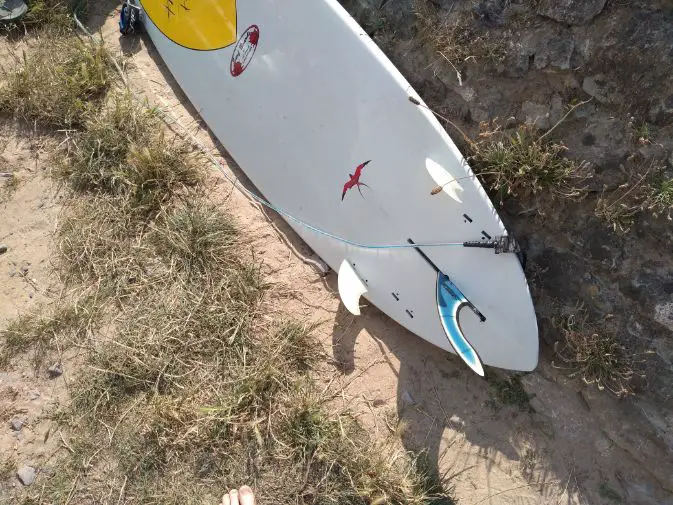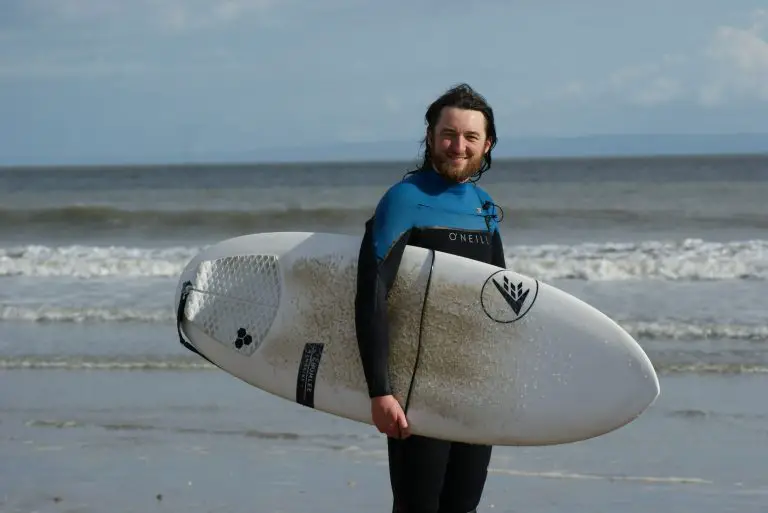How Long Should My First Surfboard Be?
Choosing the right first surfboard is a crucial step in learning to surf as getting the right board can speed up your progression and learning.
However, given that there are surfboards ranging from 4 feet to almost 10 feet in length, knowing which size board to get can be confusing.
So, I’ve prepared this guide to help you understand the perfect length of surfboard for you.
So, how long should your first surfboard be? 2 feet longer than you are tall is the golden rule, with a board that has a nice wide template and a soft construction to match will give you the ideal first surfboard length.
There are also points like rider weight to consider when thinking about the length of a first surfboard, as you can see summarized in the table below:
| Surfboard Length | Rider Weight | Rider Height |
| >9 feet(>2.75m) | >190 pounds (>86kg) | >6’0”(>1.83m) |
| 8-9 feet(2.44-2.75m) | 120-190 pounds (54-86kg) | 5’5”-6’2” |
| 7-8 feet(2.13-2.75m) | <120 pounds (<54kg) | 5’-6’ (1.5-1.83m) |
| <7 feet(<2.13m) | <100 pounds (<45kg) | <5’2” (<1.57m) |
As you can see, there are two crucial factors here, which are rider height and weight, although there are a couple of further points to consider when choosing a surfboard and its length, as we will now look at below.
Why Does Length of a Surfboard Matter for Learning to Surf?
The main reason why you will need to get a longer surfboard when learning to surf is because longer boards are more stable and float better.
The length of the board means more surface area on the water when paddling and riding.
Paddling is the way that you will get in position and catch waves, so making this easier is a great help when it comes to learning to surf. Having a board that is easy to paddle on is also a big confidence booster for learner surfers.
When you finally get to riding the board, a longer board will usually be more stable, again because there is more board beneath your feet to balance on. However, length is not the only factor here, as we’ll look at in the sections below.
Rider Weight and First Surfboard Length
To recap on the information provided above, here is the information on recommended first surfboard length (in bold) followed by a rider weight guide and estimate:
- >9 feet (>2.75m): >190 pounds (>86kg)
- 8-9 feet (2.44-2.75m): 120-190 pounds (54-86kg)
- 7-8 feet (2.13-2.75m): <120 pounds (<54kg)
- <7 feet (<2.13m): <100 pounds (<45kg)
There are a couple of further points to mention here. Some learner surfboards will come with a rider weight guideline, so definitely have a look for those before you buy any as they may vary from what you see above.
For younger riders who are going to grow, or if you are buying a surfboard for a child, then you can think about buying a board that will allow for this kind of growth.
You should probably expect to buy a learner surfboard to use for at least 1-2 years before you or the rider will want to progress onto another board.
As such, if in between sizes, it’s probably best to go for a board in the upper range from the list above just to be sure. Having a little bit more length in your first surfboard will only be a positive.
That said, you might find that your first surfboard will be extremely fun for years to come, so don’t think you won’t use it after your learning phase and progression!
Rider Height and First Surfboard Length
To help once more with this, here is the information again specifically on first surfboard length compared to the height of the rider:
- >9 feet (>2.75m): >6’0” (>1.83m)
- 8-9 feet (2.44-2.75m): 5’5”-6’2” (1.65-1.88m)
- 7-8 feet (2.13-2.75m): 5’-6’ (1.5-1.83m)
- <7 feet (<2.13m): <5’2” (<1.57m)
The key point here, which I am sure you are aware of, is that a taller rider will not fit easily onto a smaller board.
However, what this means in practice is that that person will struggle to learn since they will find that their arms and legs will be dragging in the water and that their board will feel a lot less stable.
On the opposite end, if a shorter rider gets too long a board, although it will be easy to stand up on once in the water, they may not be able to carry it.
For instance, a 9 foot long surfboard is often 23 inches wide and 2.5 inches thick, weighing around 20 pounds. For someone who is just over 5 feet tall, trying to carry this kind of board down the beach or from their car to their home will be a real frustration and might put them off wanting to go surfing.
As such, matching the board’s length with the rider’s height should help to get the right balance between ease of use and practicality, which you will definitely need.
The Hidden Factor: Surfboard Volume
Now, on top of the surfboard length and rider height and weight considerations, there is one final thing to consider, which is the volume of a first surfboard.
Volume is given in liters and gives an idea of how much float you can expect out of a surfboard. In short, the higher the volume of a surfboard, the better it will float you.
Not all surfboard manufacturers give a volume for their boards but this is becoming more and more common and helps to complete the picture of how much float a board will give you.
That being said, you do not need to obsess over volume if you follow the tips about height and also look for a board that has the right shape for learning to surf, as we’ll cover next.
First Surfboard Shapes and Templates
One of the key factors about your first surfboard is actually the shape or template of it, combined with getting the right length for your height and weight.
If you search online for ‘learner surfboards’, you should see lots of images of surfboards that have a rounded nose and tail, that is wide throughout.
Compare that to a search for ‘advanced surfboards’ and you will see much narrower, shorter surfboards that will be far less forgiving for learners and harder to progress on.
The main point here is that you should go for the most practical and generous shape of surfboard when choosing a first board since it will again help you to learn more quickly than other type of board.
I have seen so many people over the years that have tried to buy an intermediate-level or even advanced-level surfboard before they are ready. This not only slows down their progress but can also be a very costly mistake, one which you can easily avoid by following the steps outlined above.
To go further, you should also check out my full guide to choosing the right beginner surfboard for you as it will answer any other questions you have.
First Surfboard Construction
One last point is that an ideal first surfboard should be a soft foam or soft-top surfboard. This is because boards with this construction are not only forgiving but also one of the most buoyant (or ‘floaty’) kinds of surfboard out there.
This means that you will probably catch more waves on a soft foam surfboard compared to a standard surfboard of the same size.
The soft foam construction is also great for ease of care since it makes these kinds of surfboards last longer.
. This means that they are less stressful to carry around as you don’t need to worry about dropping and breaking them as much as with a normal fiberlgass surfboard.
Foam top surfboards are also safer in the surf at times when you fall off or might have a collision with other riders, which can easily happen.
For more on these kinds of great learner surfboards, check my dedicated post on foam surfboards for beginners for the full low-down!
Related Question
What is the best surfboard for a beginner? A board that is wide in the nose and tail, and has the right length and volume according to the height of the rider. A soft foam surfboard is also a great option since it will be safe and playful when learning to surf.



